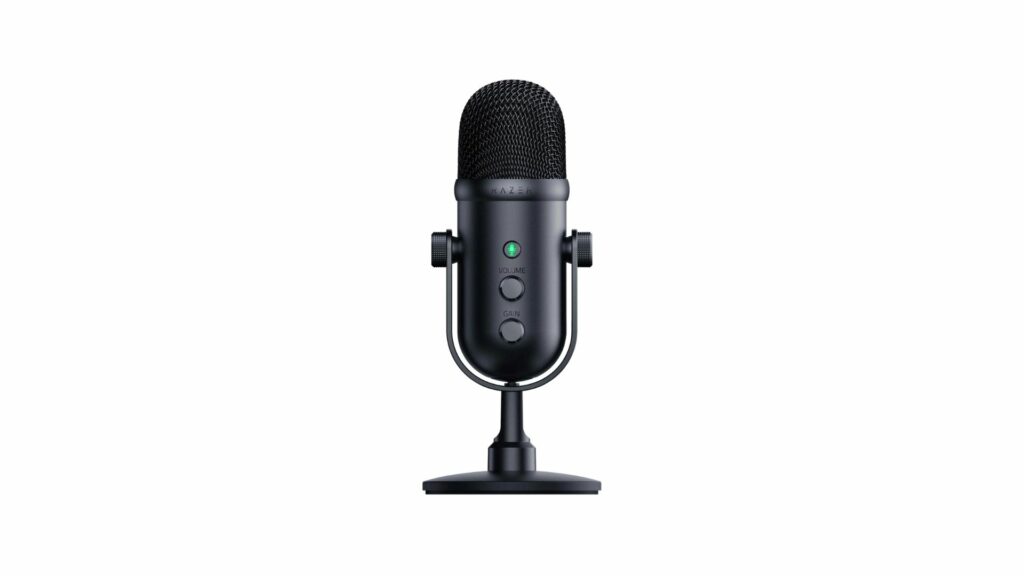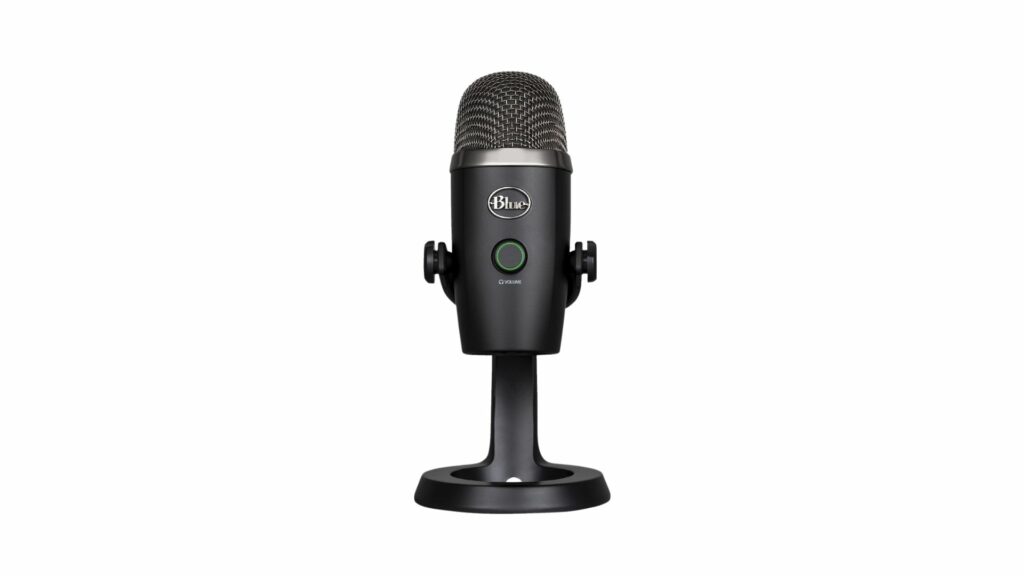Your headset mic may be good enough for Discord or in-game voice chat, but it won’t cut it for streaming or podcasting. As a content creator, you’ve got to think about the viewer experience, too, and getting a dedicated microphone is one of the biggest upgrades you can make to your setup. Not only will you sound better to your viewers, but a real streamer mic also gives your stream the authority and legitimacy that you don’t get with your off-the-rack headset mic.
Having said that we do recommend that if you want to build the ultimate setup you will need a great headset, gaming keyboard and gaming mouse.
Not sure where to start looking? We’ve put together this list of the 10 best microphones for streaming in 2023 to help you find the right mic for your needs.
Samson Q2U
The right pick if you want a starter mic with staying power
| Specs | Capsule Type: dynamic Pickup Patterns: cardioid Connectivity: USB, XLR Recording Sample Rate: 44.1khZ/48kHz Frequency response: 50–15kHz |
| Pros | Multiple connector types (XLR and USB) Dynamic mic so doesn’t pick up background noise |
| Cons | Only one pickup pattern plain jane mic design |
If you’re just getting into streaming and want a microphone that will last even as your gear evolves, no mic on the market can beat the value of a Samson Q2U. It’s a sturdy microphone that offers great sound quality and easy setup, but what really sets it apart are the USB and XLR connectors at its base.
For beginner streamers, you can plug the mic directly to a USB port and start using it in a snap. Then, as your setup grows to include an audio interface or mixer, the Q2U remains relevant—just hook it up with an XLR cable and enjoy a noticeable boost in audio quality.
You can even use the USB and XLR ports to connect the Q2U to two devices at once, which gives you a ton of flexibility with your recording setup.
Unlike most microphones in its price range, the Samson Q2U is a dynamic microphone. In “regular” recording environments, like your home or office space, a condenser mic will pick up noise from the background. Dynamic mics, like the Samson Q2U, are less sensitive to minute-level changes, so you can be sure it’s only picking up your voice.
Blue Yeti
The USB mic that can do it all
| Specs | Pickup Patterns: cardioid, omnidirectional, bi-directional, stereo Connectivity: USB Recording Sample Rate: 24-bit 48kHz Frequency response: 20–20,000Hz Features: Blue Voice, zero-latency monitoring, Smart knob controls |
| Pros | The Blue Voice software is intuitive and flexible. The LED ring makes it easy to monitor audio levels 4-capsule array for crystal-clear audio |
| Cons | The pack-in mic base is too short |
The Blue Yeti has been the best-selling USB microphone on the market for years now, and you’ve probably seen some of your favorite streamers talking into one. With a great build, distinctive design, and audio quality that rivals its more expensive competition, it’s no surprise that the Blue Yeti has been a mainstay of “best mic” lists since its release.
The Yeti is built to last, coming in at 3.4 pounds when fixed to its desktop stand. It sounds great, too, thanks to the three high-quality condenser capsules under its grill, which are situated to allow for multiple pickup patterns.
And since the Yeti is USB-powered, you won’t need any extra gear to get started; it’s as plug-and-play as mics get!
The Yeti’s biggest selling point is its ability to toggle between four pickup patterns—-cardioid, omnidirectional, bi-directional, and stereo. This makes it a great pick if you need a general-purpose mic for streaming solo, recording interviews, and couch gaming with friends.
HyperX Quadcast S
The sleekest RGB mic on the market
| Specs | Pickup Patterns: cardioid, omnidirectional, bi-directional, stereo Connectivity: USB-C to USB-A Recording Sample Rate: 16-bit 48kHz Frequency response: 20–20,000Hz |
| Pros | Great sound quality adjustable RGB color scheme Four pickup patterns and a mute button |
| Cons | Can’t be removed from the shock mount |
Gaming gear is known for its crazy, over-the-top RGB LED options, yet it’s surprisingly hard to find a gamer-oriented microphone with decent RGB features. HyperX set out to fill that void with the Quadcast S, a mid-range microphone with full RGB lighting that’s boosted by a feature-rich yet intuitive software package.
With the Quadcast S, beauty is more than simply skin deep; it also has all the bells and whistles you’d expect from a microphone in its price range (and even a few that you won’t). You can pick from four recording patterns, giving it the same versatility of the excellent Blue Yeti, but it also comes with a great shock mount and on-mic headphone monitoring. And then there’s the RGB lighting options, which look great and are easy to program from the HyperX software.
If you want a mid-range streaming mic that both looks and sounds great, the HyperX Quadcast S is the mic for you.
Elgato Wave:3
The pick for those who want full control of their audio streams
| Specs | Pickup Patterns: cardioid Connectivity: USB-C Recording Sample Rate: 24-bit Frequency response: 70–20,000Hz |
| Pros | Wavelink software is excellent Great vocal audio quality Built-in anti-peaking filters |
| Cons | Weird, touch-activated mute button |
Elgato is known for its streamer-oriented hardware, from low-cost cameras and affordable capture cards to professional streamer decks and more. Now, the company is taking that expertise to microphones with the Elgato Wave series.
The Wave:3 provides crisp audio capture quality, making it a solid choice for home recording purposes. Where it truly excels is in live streaming, which should come as no surprise as that’s Elgato’s bread and butter.
A key part of the Wave:3’s appeal lies in its seamless integration with Elgato Wavelink. The Wavelink software gives you unmatched flexibility and control over your audio streams, allowing you to route your audio sources however you want.
If you’re already in the Elgato ecosystem, the Wave:3 should be a no-brainer purchase. Not only does it look great on stream, it sounds incredible and integrates painlessly with other Elgato devices. For everyone else, the advanced Wavelink functionality is a strong argument to add the Wave:3 to your shopping list.
Razer Seiren Pro V2

Flexibility and elegance from a top gamer accessory maker
| Specs | Pickup Patterns: cardioid Connectivity: USB-A to USB-C Recording Sample Rate: 24-bit 96kHz Frequency response: 20–20,000Hz |
| Pros | 96kHz recording sample rate sounds incredible Built-in high pass filter Elegant mic design |
| Cons | Have to tinker with settings to get good recording quality |
Razer is one of the most recognizable gaming gear brands in the world, but when it comes to microphones, they’re relative newcomers. Unlike their mice and keyboards, which are clearly designed for gamers, crazy RGB configurations and all, the Razer Seiren Pro V2 is a simple, pill-shaped mic with a subtle class that integrates well with any workspace.
Perhaps knowing that they can’t quite compete with audio industry titans head-on, the Seiren series of microphones instead focus on pure audio quality and ease of use. They’ve absolutely nailed it; the Seiren sounds warm and crisp with a slight bass boost for presence.
The mic also features volume and gain sliders and a mute button on its face, so you can quickly adjust your levels on the fly.
The Razer Seiren Pro V2 is a sophisticated offering from a top hardware maker and a great pick for both amateur streamers and professional content creators.
Blue Yeti Nano

The best portable mic for streaming on the road
| Specs | Pickup Patterns: cardioid, omnidirectional Connectivity: USB Recording Sample Rate: 24-bit 48kHz Frequency response: 20–20,000Hz |
| Pros | Recording quality rivals its more expensive siblings Tiny form factor for ultra portability Illuminated control dial allows for easy level adjustments |
| Cons | Not much cheaper than a Blue Yeti |
Don’t be fooled by the Blue Yeti Nano’s tiny form factor; this thing packs a punch! This minified version of the premium Blue Yeti X isn’t just super easy to fit into a travel bag, it also boasts audio reproduction quality that rivals its more expensive siblings.
As its name suggests, the Yet Nano is small, weighing in at just over a pound when fixed to its stand. That doesn’t mean Blue have sacrificed build quality at all—it’s as sturdy as any mic you’ll find and can easily handle years of suitcases and long trips.
The audio quality is its most impressive feature. Not only does it sound good considering how small it is, it rivals the Blue Yeti X! This makes it an obvious pick for professional voice recorders and streamers who are always on the go. You do have to give up two pickup pattern options (the Nano only has cardioid and omnidirectional options), but that’s a minor sacrifice for its portability.
Need a mic that you can toss into a bag and take with you everywhere you go? You won’t find many mics better than the Blue Nano Yeti.
Shure SM7B
Premium quality recording for those with cash to spare
| Specs | Capsule Type: dynamic Pickup Patterns: cardioid Connectivity: XLR Recording Sample Rate: 24-bit 192kHz Frequency response: 50–20,000Hz |
| Pros | Unmatched recording quality (192kHz!) Best in its class so you’ll never have to upgrade again Excellent on-board filters |
| Cons | Requires a preamp Expensive! |
Michael Jackson recorded his historic “Thriller” album with an array of SM7 microphones. If that isn’t enough to convince you of the quality of Shure’s SM7B, we don’t know what to tell you. Sure, it’ll cost you a pretty penny, but you get what you pay for: truly studio-level audio fidelity and a quality build.
Unlike many of the mics on this list, the Shure SM7B was made with one purpose: vocal recording. Live streamers, podcasters, and video content creators will fall in love with the SM7B’s warmth and clarity. Its vocal reproduction is also impressively accurate—select a flat frequency response and you’ll hear exactly how you sound to other people (for better or for worse).
Get the Shure SM7B if you never want to upgrade your microphone again. Its build and audio quality is unparalleled, even at its price range. Just be ready to part with a good chunk of your money.
Audio-Technica AT2020
A pricey pick but you’ll never need to upgrade again
| Specs | Capsule Type: condenser Pickup Patterns: cardioid Connectivity: XLR Recording Sample Rate: 16-bit 44.1/48kHz Frequency response: 20–20,000Hz |
| Pros | Great audio recordings for its price Durable |
| Cons | Requires a preamp to get started |
Audio-Technica is a big name in audio equipment, and its AT2020 condenser microphone certainly lives up to the brand’s reputation.
The AT2020 is the best-sounding microphone you’ll find for under $100. Its audio recording and reproduction is clear and accurate and far beyond what you’d typically find at this price point.
That said, prepare to spend some money on the appropriate equipment if you want to get the most out of the AT2020. All you get is the mic itself, so you’ll need an XLR cable, a mic stand, and a preamp to even get started.
The AT2020 is also much bigger and clunkier than the other mics on this list. That’s not necessarily a bad thing—it fits right into a podcast environment, for example—but prepare to do a bit of adjusting to get it in a comfortable position in frame. It’s worth it, though, for the warm and clear audio recordings you get.
Need professional-level audio quality without breaking the bank? The Audio-Technica AT2020 is the mic for you. You’ll need a bit of prep to get started, but once it’s all set up, you won’t find anything at this price range that beats it.
Roccat Torch
A straightforward experience for streamers who just need a mic
| Specs | Pickup Patterns: cardioid, stereo, whisper Connectivity: USB Recording Sample Rate: 48kHz Frequency response: 20–20,000Hz |
| Pros | Adjustable knobs on base make for easy audio adjustments Clean RGB setup that’s flashy without being corny Easy to setup and use |
| Cons | Short mic stand Doesn’t really work with boom mic stands |
The Roccat Torch is a streamer mic designed for simplicity and ease of use. Not everyone wants to be a professional voiceover artist; in fact, the sound resolution of the higher-end mics are wasted on most streamers anyway. If you need a microphone that just works out of the box, the Roccat Torch will have you ready to go in no time.
The Torch offers a plug-and-play experience that’s more than adequate for Discord or a Twitch stream. And if you’re the type who prefers an overnight stream, the mic comes with a Quiet Mode, so you can speak at a lower volume while staying audible to your audience.
No, it probably won’t cut it if you want studio-quality audio for professional voiceovers, but most people won’t need that anyway. With its distinctive design and elegant RGB options, the Roccat Torch is the perfect USB microphone for streamers who just want something that works.
Rode NT-USB-Mini
Top audio quality in a portable form factor
| Specs | Pickup Patterns: cardioid Connectivity: USB-C Recording Sample Rate: 48kHz Frequency response: 20–20,000Hz |
| Pros | Easy setup Headphone output for real-time monitoring Sounds great |
| Cons | No gain control Stiff stand |
Rode makes some of the best microphones in the business, but for the longest time, they didn’t have anything that appealed to amateurs on a budget. That all changes with the Rode NT-USB Mini, a portable mic with the audio quality and aesthetics you’d expect from Rode at under $100.
Since it plugs into your USB port, using the NT-USB Mini is just a matter of hooking it up to your computer or laptop. Its design is about as barebones as you can expect from a USB mic, but Rode makes up for it with its Rode Connect software, a digital mixer that lets you hook up and control up to four NT-USB Minis on a single machine.
If audio quality is what you’re looking for, the sub-$100 Rode NT-USB-Mini is a compelling option. It’s easy to set up and sounds great out of the box. And it’s tiny enough that you can safely fit several of them in a travel bag or backpack, and with the Rode Connect software, you can set up ad hoc group podcasts and streams in no time.
Frequently Asked Questions
If you’re looking to capture loud, strong sounds, like vocals and drums, then a dynamic microphone is your best choice. More delicate sounds and higher frequencies can be captured by using a condenser microphone in a studio environment.
In contrast, a condenser microphone requires external power, but a dynamic microphone doesn’t. Consequently, a condenser microphone will require an external power supply, which might come from a preamp, an audio interface or your USB port.
You may have noticed there are four primary microphone polar patterns on this list: cardioid, omnidirectional, stereo, and bi-directional.
But what are the differences between the polar patterns?
Mics with a cardioid polar pattern (also known as unidirectional) are most sensitive to audio in a semi-circle in front of the mic and reject audio from behind the mic. This is the most popular polar pattern because it’s the most appropriate for vocal recording. A cardioid pattern is what you’re looking for in most cases as a streamer.
Mics with an omnidirectional polar pattern capture audio from all directions. This polar pattern works for roundtable sessions, but can be hard to work with because it picks up background noise from everywhere.
The stereo polar pattern picks up audio on the left and right of the microphone. Typically, these mics will send two audio channels to your machine: Left and Right. This type of polar pattern is great for interviews and podcasts—just stick your mic in the middle and have both speakers on either end. The stereo pattern is also the pattern of choice for ASMR streams.
The bi-directional polar pattern picks up audio directly in front and behind the microphone while rejecting sound from the sides. This also works great for interviews and podcasts.
If you want the best in quality, then you should look for an XLR microphone. XLR mics typically have higher sample rates and deliver crisper audio than their USB counterparts.
However, XLR condenser mics require an external power source in order to be audible at all. That means they won’t work unless you have a preamp, mixer, or audio interface with a 48V power source.
Where USB microphones win out is in ease-of-use—just plug them in and you’re ready to go. They draw power from your USB port to amplify their audio, so you won’t need a preamp to get them working. However, since your USB port only provides 5V of power, don’t expect the same quality or dynamic range of an XLR mic.

A gaming lover from a very young age, Justin has always had a keen eye for building his own computers or racing sims so that he can race his identical twin (and usually lose at the actual race).
Justin in the founder of BeStreamer and sees it as a free resource to help all gamers around the world



